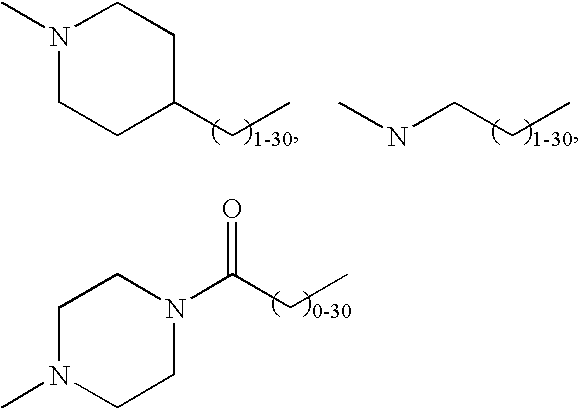Modified proteins
a technology of modified proteins and glycoproteins, applied in the field of modified proteins, can solve the problems of undesirable in vivo plasma half-life of certain therapeutically active glycoproteins, and achieve the effects of prolonging the circulating half-life of such glycoproteins, prolonging the circulating half-life of soluble glycoprotein derivatives, and reducing the quantity of injected material and frequency of injections
- Summary
- Abstract
- Description
- Claims
- Application Information
AI Technical Summary
Benefits of technology
Problems solved by technology
Method used
Image
Examples
examples
[0161]Abbreviations:
[0162]SDS-PAGE: sodium dodecyl sulphate—polyacrylamide gel electrophoresis
[0163]EDTA: ethylenediamino tetraacetic acid
[0164]FVIIa: Factor VIIa
[0165]FVIII: Factor VIII
[0166]FIX: Factor IX
[0167]Materials, Apparatus and Methods
[0168]Purifications:
[0169]Protein purifications on ion-exchange column (HiTrap Q HP, Amersham Bioscience) or size exclusion column (XK26 / 60 HiLoad Superdex 200, Amersham Bioscience) were performed using an Äkta FPLC, with a FC-950 fraction collector (Amersham Bioscience). Elution buffers, columns and fraction collector were thermostated at 5° C.
[0170]SDS-PAGE:
[0171]SDS-PAGE was performed using Invitrogen™'s Xcell Surelock™ Mini-Cell system with pre-cast 4-12% Bis-Tris gels, NuPAGE MES SDS running buffer, Mark 12 standard and NUPAGE LDS sample buffer according to Invitrogen's standard protocol. Gels were stained with SimpleBlue™ according to Invitrogen protocols.
[0172]Buffer Solutions
[0173]GlyGly buffer: 25 mM Gly-Gly, 50 mM NaCl, 25 mM CaCl2, ...
example 1
[0181]10KPEG-ONH2: 10K-SMB-PEG (1.00 g; 0.1 mmol; Nektar Inc) was dissolved in DCM (10 ml). 4-(N-t-butoxycarbonylaminoxy)butylamine (0.20 g, 1 mmol, prepared as described in WO 2005014049 A2) was added and the mixture was stirred at rt. for 16 h. Diethylether (90 ml) was added and the white precipitate was filtered off. The process was repeated by redissolving the precipitate in DCM (10 ml) and adding diethylether (90 ml). The precipitated material was then redissolved in DCM (6 ml) and Amberlyst 15 ion exchange resin (2.0 g; previously washed with DCM and 10% EtOH in DCM) was added. The mixture was stirred for 30 min at rt, then the resin was filtered off, and washed extensively with DCM. The combined DCM solutions were concentrated to a minimal volume on a rotary evaporater, then diethylether (90 ml) was added to precipitate the product. The product was dissolved in DCM (6 ml) and TFA (6 ml) was added. The mixture was stirred at rt for ½ h. Product was precipitated with diethyleth...
example 2
[0182]mono 10K-PEG-FVIIa (0128-0000-1018-1A):
[0183]Factor VIIa (14 mg, 0.28 umol) dissolved in 10 ml 25 mM Gly-Gly, 50 mM NaCl, 25 mM CaCl2, pH 6.0 (GlyGly buffer) was added 100 ul of a 20 mM NaIO4 solution in CaCl2 free GlyGly buffer and 1000 ul of a solution of 10K-PEG-ONH2 (Example 1, 42 mg; 4.2 umol; 15 eqvivalents relative to factor VIIa) in GlyGly buffer. The mixture was placed on ice for 2 h, with occasional shaking. 500 ul of a solution of MeONH2.HCl (17 mg; 0.21 mmol) in GlyGly buffer (pH adjusted to 6.0 with 1M NaOH) was then added to the reaction mixture. The mixture was left on ice for additional 10 min. The reaction mixture was then added a cold solution of 100 mM dibasic EDTA (4.5 ml) while maintaining pH below 9.0. pH was then adjusted to 8.0 using 100 ul 1N aqueous HCl.
[0184]Ion-Exchange Chromatography:
[0185]Excessive PEG-ONH2 was removed by ion exchange chromatography. The cooled reaction mixture was loaded on to a 5 ml HiTrap Q ion-exchange column (Amersham Bioscie...
PUM
| Property | Measurement | Unit |
|---|---|---|
| molecular weight | aaaaa | aaaaa |
| molecular mass | aaaaa | aaaaa |
| molecular weight | aaaaa | aaaaa |
Abstract
Description
Claims
Application Information
 Login to View More
Login to View More - R&D
- Intellectual Property
- Life Sciences
- Materials
- Tech Scout
- Unparalleled Data Quality
- Higher Quality Content
- 60% Fewer Hallucinations
Browse by: Latest US Patents, China's latest patents, Technical Efficacy Thesaurus, Application Domain, Technology Topic, Popular Technical Reports.
© 2025 PatSnap. All rights reserved.Legal|Privacy policy|Modern Slavery Act Transparency Statement|Sitemap|About US| Contact US: help@patsnap.com



